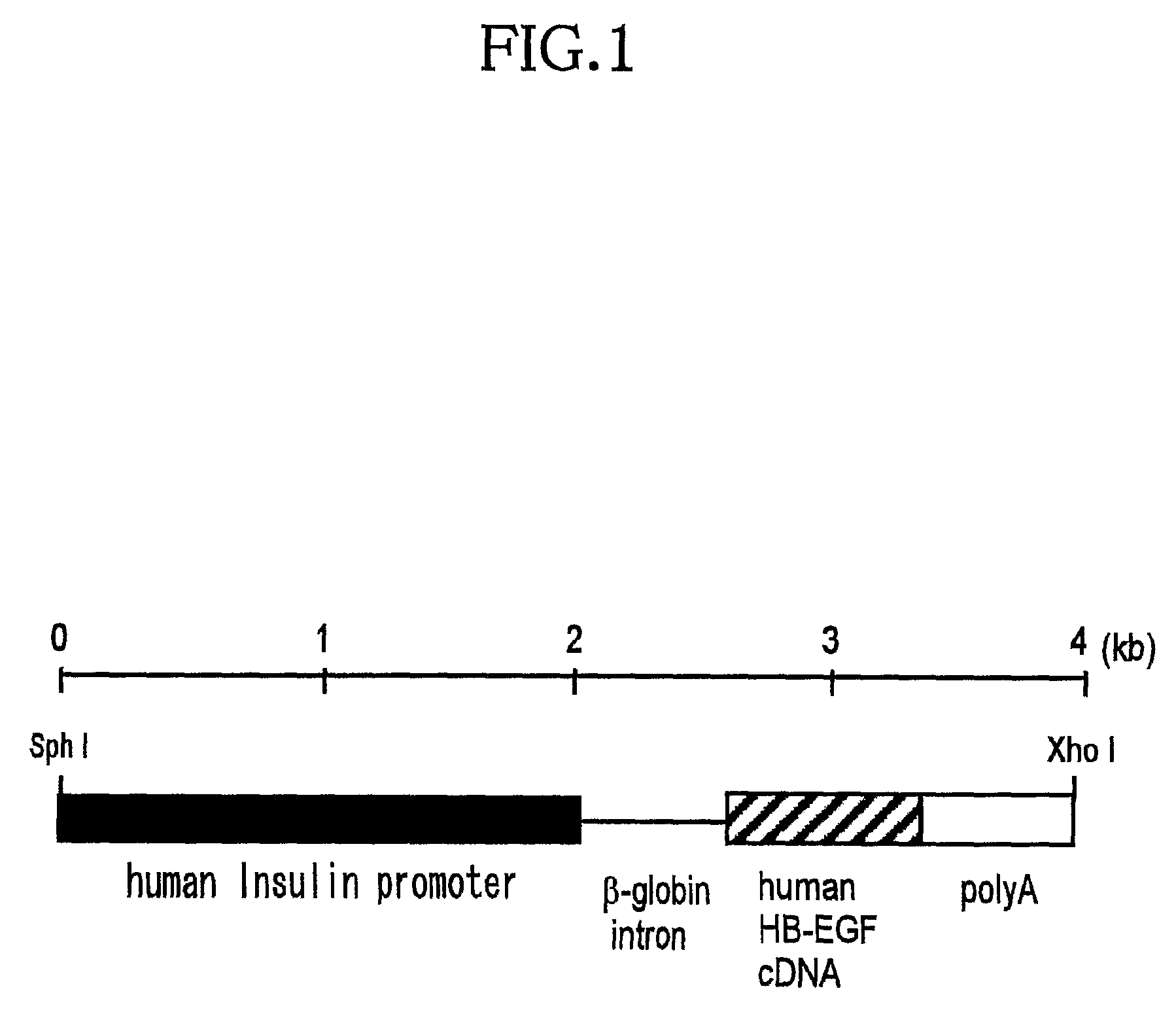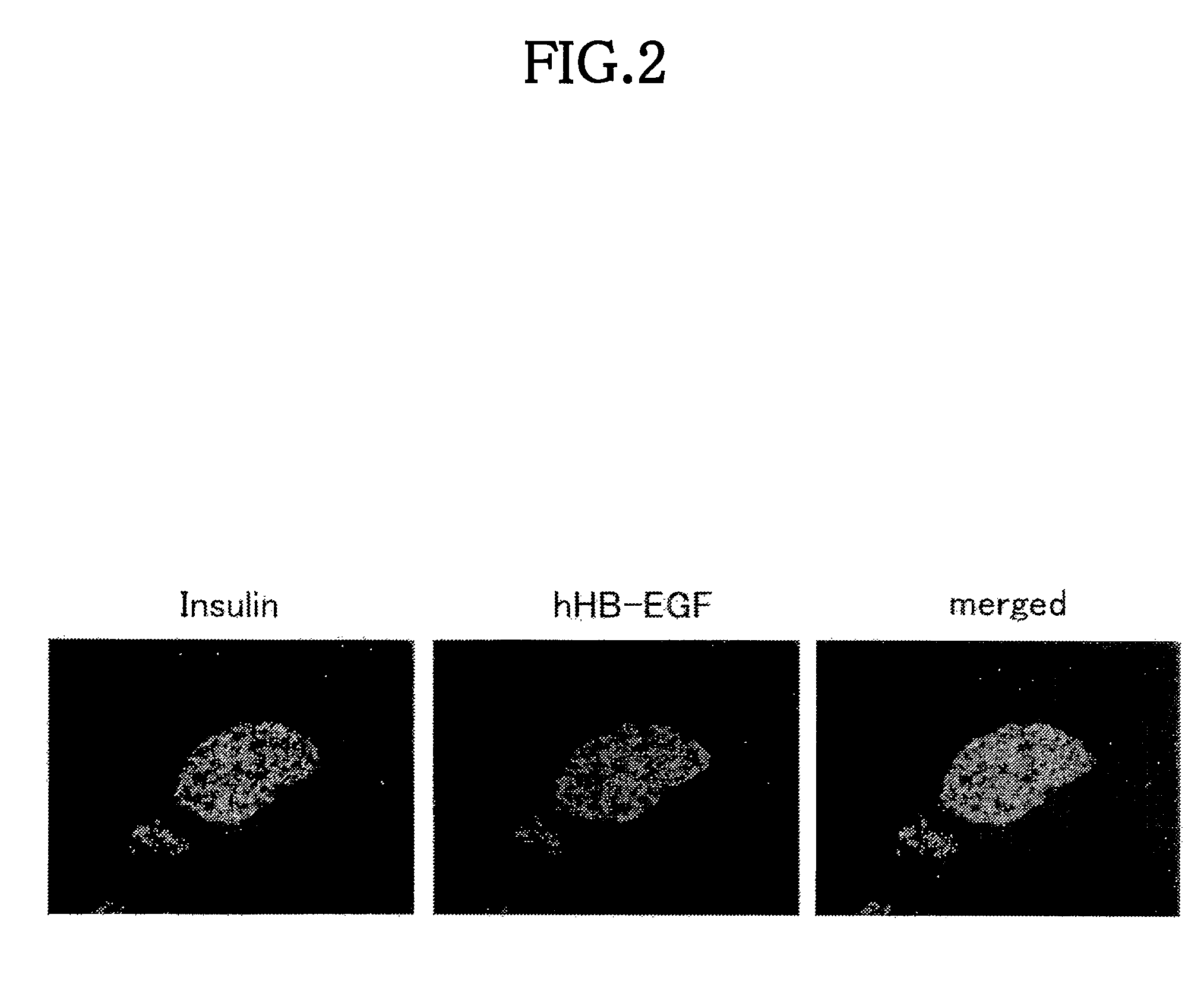Diabetes model animal
a model animal and diabetes technology, applied in the field of diabetes model animals, can solve the problems of (1) efficiency and reproducibility of induced diabetes, (2) side reactions to other organs and cells such as renal damage, and achieve the effect of easy differentiation
- Summary
- Abstract
- Description
- Claims
- Application Information
AI Technical Summary
Benefits of technology
Problems solved by technology
Method used
Image
Examples
example 1
Production and Function Analysis of the First Diabetes Model Mouse
[1] Method
[1-1] Construction of a Transgene for Production of the Transgenic Mouse
[0073]For preparation of the transgene (expression unit), human HB-EGF cDNA was cut out from the plasmid pRcHBEGF (EMBO J. 13, 1994, 2322-2330) by the restriction enzymes Hind III-Not I, and it was made to have the blunt end by using DNA Blunting Kit (TaKaRa). Then, the human HB-EGF cDNA was inserted (at Eco RI site) in the downstream of human insulin promoter (1.9 kb), within the plasmid pIns-1 (J. Exp. Med. Vol. 188, Oct. 19, 1998, 1445-1451), to obtain the plasmid pIns-TR1.
[0074]The fragment of 3.8 kb was cut out from the above plasmid pIns-TR1 by the restriction enzymes Sph I-Xho I, which was purified by use of QIAquick Gel Extraction Kit (QIAGEN) and then used as the transgene (FIG. 1).
[1-2] Production of the Transgenic Mouse
[0075]The above transgene was introduced into fertilized eggs obtained from C57BL / 6J Jcl×C57BL / 6J. Jcl. Then,...
example 2
Production and Function Analysis of the Second Diabetes Model Mouse
[0091]The transgene used for production of the second diabetes model mouse is shown in FIG. 9. The transgene has structure of “rat insulin II promoter (about 600 bp)—rabbit beta-globin intron (omission in FIG. 9)—human HB-EGF cDNA—IRES—PTimer—rabbit beta-globin polyA signal (omission in FIG. 9)” arranged in this order.
[0092]Using the above transgene, the transgenic mouse was made according to a known procedure as discussed above. As a result, seven lines of mice having the sequence of the above transgene were obtained. After the diphtheria toxin was intraperitoneally administrated into two lines of mice among these mice in a single-dose of 250 ng, the blood glucose level clearly increased in these two lines of mice in the 2nd-3rd day after the administration (FIG. 10). Then, the state of the hyperglycemia continued over several weeks. In the mice where the blood glucose level increased, various symptoms such as polyu...
PUM
| Property | Measurement | Unit |
|---|---|---|
| thickness | aaaaa | aaaaa |
| concentration | aaaaa | aaaaa |
| concentration | aaaaa | aaaaa |
Abstract
Description
Claims
Application Information
 Login to View More
Login to View More - R&D
- Intellectual Property
- Life Sciences
- Materials
- Tech Scout
- Unparalleled Data Quality
- Higher Quality Content
- 60% Fewer Hallucinations
Browse by: Latest US Patents, China's latest patents, Technical Efficacy Thesaurus, Application Domain, Technology Topic, Popular Technical Reports.
© 2025 PatSnap. All rights reserved.Legal|Privacy policy|Modern Slavery Act Transparency Statement|Sitemap|About US| Contact US: help@patsnap.com



